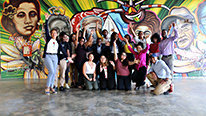- Rodney Hopson
- https://education.illinois.edu/people/rodney-hopson#tab3
- Professor
- Creating a STEM evaluation community of practice to address the interdisciplinary and transdisciplinary potential to use culturally responsive and other relevant evaluation and research methods in broadening participation (BP) programs and projects
- University of Illinois at Urbana-Champaign, Urban Institute, American Eval Assn
- Brandi Gilbert
- https://www.urban.org/author/brandi-gilbert
- Research Associate
- Creating a STEM evaluation community of practice to address the interdisciplinary and transdisciplinary potential to use culturally responsive and other relevant evaluation and research methods in broadening participation (BP) programs and projects
- Urban Institute
- Kelly Giles
- Doctoral student
- Creating a STEM evaluation community of practice to address the interdisciplinary and transdisciplinary potential to use culturally responsive and other relevant evaluation and research methods in broadening participation (BP) programs and projects
- University of Massachusetts-Amherst
- Esther Nolton
- https://www.linkedin.com/in/esther-nolton-303bab91/
- Doctoral Student/Evaluation Scholar
- Creating a STEM evaluation community of practice to address the interdisciplinary and transdisciplinary potential to use culturally responsive and other relevant evaluation and research methods in broadening participation (BP) programs and projects
- George Mason University
- Ananya Tiwari
- https://www.linkedin.com/in/ananya-tiwari-0875b9130/
- PhD Student
- Creating a STEM evaluation community of practice to address the interdisciplinary and transdisciplinary potential to use culturally responsive and other relevant evaluation and research methods in broadening participation (BP) programs and projects
- University of Illinois at Urbana-Champaign
Public Discussion
Continue the discussion of this presentation on the Multiplex. Go to Multiplex











Rebecca Roberts
Interesting project- could you expand on your definition and assessment of quality engagement by faculty and discuss how that is promoted and supported on the campuses?
Ananya Tiwari
PhD Student
The Literature reports through students' description around quality engagement by faculty members - wherein how a faculty conducts himself/herself in class interactions and outside, formally and informally (in terms of accessibility and responsiveness to people of colour), determines whether a person is truly engaged in the cause. We also found that measures like proper recruitment of faculty (diverse and sensitive), their training towards these needs, constantly working on mentor-mentee relationships, higher university leadership signalling etc. are all important factors in this regard.
Rodney Hopson
Professor
Hello and welcome to our presentation of the NSF EAGER GEDI STEM Project.
We have provided a video for you to see and hear for discussion and questions.
Expect us to chime in based on questions and responses this week.
Best,
Rodney (and the NSF EAGER GEDI team)
Becca Schillaci
Research Associate
Thank you for summing up the literature on the important programmatic elements to include in order to broaden participation in STEM. What is the next step for your project?
Ananya Tiwari
PhD Student
Immediate steps include more dissemination and documentation. Also, collaboratively deciding with NSF and our advisory board which of our ideas should we further? Whether to delve into more literature or undertake a fresh research program ourselves.
Gregory Rushton
Director, TN STEM Education Center
Hi, thanks for sharing your work with us...do you think participation in research is a scalable solution? Isn't there some carrying capacity for research groups, especially if they're externally funded, that would limit the ability for the system to support BP initiatives at some level? Wondering about your thoughts on this.
Ananya Tiwari
PhD Student
Very interesting question. I feel that generally all grants in near future (it has already begun) will push for a BP branch in the project. Apart from that, we would also need to diversify research experiences and help students undertake smaller community based projects or projects through crowdfunding or clubbing them with advanced PhD or post doc fellows for research experience. It is important to constantly advocate for it at the strategic level so that the effect also trickles down at the funding level.
Frank Davis
Hi Rodney,
The video certainly provided an excellent summary of a comprehensive look at the issues of broadening participation in the post-secondary context where NSF has supported major research efforts. My evaluation and research work has been more focused on secondary education, particularly public schools serving primarily poor children of color. I was wondering if your team had an opportunity to reflect on the issues of culturally responsive evaluation at this level. I could imagine that some of the summary points in the video at this level of a STEM education pipeline would still hold true.
Ananya Tiwari
PhD Student
Hi Frank,
Although we deliberately restricted ourselves to higher education, you are right in identifying that many of the factors with a slight change will overlap for secondary education as well. In many instances, exposure to research took place at secondary education level which became a strong factor for pushing people of colour to pursue higher education in STEM. Similarly, good guidance/mentorship is also extremely critical at this level. As you might agree, there is also evidence around information asymmetry or misconceptions around STEM areas which hinder people of colour in actually going for it - support from teachers or counsellors would be extremely effective in this regard. As you pointed out, factors like a well designed program with integrated CRE element right from the beginning for such schools is crucial, so is continuity in undertaking evaluation placing cultural responsiveness at the centre.
These are my two cents but this definitely calls for a longer discussion.
Monae Verbeke
Senior Research Associate
Hi all! This project looks like it has a lot of potential. I wonder if your literature search uncovered any differences in evaluation and BP across fields or within different countries?
Ananya Tiwari
PhD Student
Very pertinent question. For this specific project we focused only on STEM areas and US based projects, but it will be very interesting to see how this gets manifested in areas you suggested.
Further posting is closed as the showcase has ended.